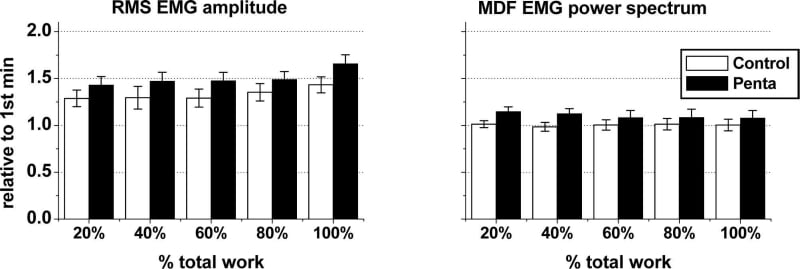We investigated whether Penta® water (ultra-purified, restructured, metastable bottled water, PW) enhanced muscle performance relative to other bottled water (BW) during a performance test (PT) completed after prolonged steady state (SS) exercise. The study received approval from London South Bank ethical committee, and was performed according to the Declaration of Helsinki. Ten male recreational/well-trained cyclists (age: 34 ± 3 years, VO2max: 4.05 ± 0.13 l min-1, weight: 84.9 ± 4.6 kg, height: 1.81 ± 0.03 m) participated in 2 double blind trials separated by 2 weeks and allocated by systematic rotation (PW vs BW). Subjects were overnight fasted and had consumed the same diet and performed same training for 48h prior to each trial. Subjects completed 30 min cycling at 70 % VO2max, followed by 3 x 50 s raised efforts (double 70% VO2max work load) interspersed with 2 min rest; then 45 min cycling at 70% VO2max (SS) prior to PT. During PT, subjects completed an individualised set volume of work, equal to 4 min at 95% Workmax. A 6ml kg-1 bolus was consumed immediately pre-exercise and then 2 ml kg-1 (PW or BW) every 15 min. Expired air (MSX, Ferraris UK) was analysed breath-by-breath and blood samples taken at regular intervals pre-, during and post-exercise. Biomechanical data were collected from Lode ergometer and vastus lateralis activity was assessed using surface electromyography (EMG, B&L Engineering, USA; CED, UK) throughout the protocol. 1 min averages for EMG and biomechanical data were calculated at beginning, middle and end of each SS period and for each 20% work completed during PT. Data were normalised against corresponding values during the first minute of SS and presented as mean ± S.E.M. Blood samples were analysed for plasma volume change (Dill et al. 1974), and plasma osmolality (osmometer, Roebling, UK) was measured. There were no differences between trials (2 way ANOVA) in any of the measured variables during SS exercise (66 ± 2% VO2max). However, subjects completed PT significantly faster for PW (258 ± 13 s) than BW trials (275 ± 7 s, P = 0.04, Student’s paired t test). Neither plasma volume change nor osmolality were different between conditions although there were significant changes over time, indicative of dehydration (both P < 0.05). The amplitude of the surface EMG (as an index of the muscle activation level) and the EMG power density spectrum (as an estimate of the action potential conduction velocity) are used to describe the recruitment and the pattern of motor units activity during a contraction (for a recent review see Farina et al. 2004). Therefore, for Penta® water trials, the EMG data indicate an ability to recruit a larger muscle mass and to sustain higher conduction velocities during the performance test, than for BW trials. This resulted in a higher power output and faster completion of the task during PW trials. The mechanism could be attributed to both neural control as well as peripheral factors, but it is not possible to differentiate between these two putative mechanisms with the current data.
University of Bristol (2005) J Physiol 567P, PC220
Poster Communications: Effect of different bottled waters on human skeletal muscle performance
Mileva, Katya; Seth, Kavita Devi; Bowtell, Joanna;
1. Academy of Sport, Physical Activity and Well-being, FESBE, London South Bank University, London, United Kingdom.
View other abstracts by:
Figure 1. Normalised RMS EMG amplitude (P = 0.03) was higher and median frequency (MDF) of EMG power spectrum (P = 0.06) tended to be higher throughout the performance cycling test in Penta water (PW filled bars) than in other bottled water (BW open bars) trials (2 way ANOVA n = 7; data from 3 subjects were excluded from the analysis due to technical reasons). Data are averaged over each 20% work completed during the performance test.
Where applicable, experiments conform with Society ethical requirements.

